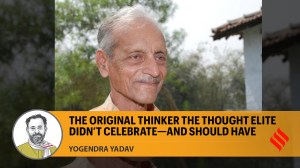Using the dark web, online ads and internet therapy to prevent child sexual abuse
A new online program hopes to prevent child sexual abuse before it happens by helping people who struggle with their sexual urges involving children.
 Child sexual abuse and imagery related to it is rampant across the dark web. (Image credit: Vishnu Ram / Express photo)
Child sexual abuse and imagery related to it is rampant across the dark web. (Image credit: Vishnu Ram / Express photo) Child sexual abuse is a global concern that law enforcement officials and policymakers are having a difficult time tackling. But what if you could prevent it from happening instead of tackling criminals afterwards? That is exactly what a group of researchers and clinicians in Europe have set out to do with the “Prevent It” program
“Prevent It,” is a nine-week cognitive behavioural therapy program aimed at people who are concerned about their sexual urges involving children. The program is anonymous and free of cost, and the researchers plan to reach out to participants through search and social media ads as well as forums on the Darknet.
“Each week, the participants watch a short video and they read some psycho-educative texts. One of the core components of CBT is the interconnectedness between thoughts, feelings and behaviours. So, we work on changing one part of this triangle so that it changes the others,” said Malin Joleby, one of the coordinators of the project, to indianexpress.com. Joleby is a researcher at the Karolinska Institute in Sweden, which developed the project.
The Prevent It project is EU-funded and is an international collaboration between researchers in Sweden, Germany, Portugal, the United States and Canada. A pilot study of the program was conducted in 2019 to 2021 and focused on individuals who used child pornography. The results of the pilot study were published in the journal Internet Interventions in December last year.
Finding participants to recruit to the program
While the program is promising and could potentially prevent child sexual abuse (CSA) before it happens, it wouldn’t be very effective if people did not join it in the first place.
“The idea for this outreach approach that we use came from the patient group itself. In a previous clinical trial of a pharmacological treatment of paedophilic disorder, our research group leader at Karolinska Institutet, Christoffer Rahm, interviewed the participants,” explained Joleby.
During his interviews, Rahm asked people with paedophilic disorder about how researchers and psychologists can reach out to them. Participants told him that psychologists cannot sit and wait for patients. They will have to find them by being where they are. This is why the researchers began reaching out to people on darknet forums where people discuss CSA or share material related to it.
“When my colleagues first started interacting in these darknet forums, they received different reactions. Many were understandably sceptical and afraid that they were undercover agents. In the beginning, they often got kicked out and were sometimes met unkindly,” Joleby explained.
But over time, they gained trust in the forums by being polite, open and transparent about who they are (researchers from Karolinska Institutet) and what they are trying to do (offer free and anonymous treatment). According to Joleby, even owners and administrators who are high up in the hierarchy of these forums recommend the program to their members.
The researchers also advertise on social media and search engines. For example, if someone searches for an illegal term or related content, they will be met with information about the treatment program and an opportunity to join it.
Apart from these outreach techniques, the researchers also have a cooperation with law enforcement officials. Police will assist the researchers in handing out information about the study to individuals who the police suspect but are not yet convicted or incarcerated.
However, the police cannot follow up whether the suspects choose to sign up for the program, or how they are doing in the program. This is important because the program can only be effective if the participants can remain completely anonymous.
Updates to improve the “Prevent it” program
While the program is effective and has been designed very carefully to have the intended effect of preventing CSA, the researchers observed a significant drop-out rate, and since it is completely anonymous, it is not possible to follow up with those who dropped out.
“We have made some changes and improvements to the treatment program and these are all based on feedback from the participants in the pilot study, from therapist experiences and statistical analyses,” said Joleby about how the researchers are tackling this problem.
For example, initially, the first parts of the program included quite demanding work. This has now been rearranged to let the participants ease into the program. The new and updated version of the program also has more examples and guidance to make it easier to follow for participants.
But at the end of the day, since the program is completely anonymous, once a participant logs out, the researchers can never reach out to them or follow up to see if they can return.
Will the program work in India?
Despite that drawback with the program, it could prove to be an important tool that can help the fight against child sexual abuse, which is especially important in a country like India, which is home to almost 19 per cent of the world’s children.
An Indian government-funded study conducted in 2007 which interviewed 125,000 children in 13 Indian states found that all forms of child abuse is extremely prevalent in India, including physical abuse (66 per cent), sexual abuse (50 per cent) and emotional abuse (50 per cent).
Indianexpress.com spoke to Binita Das Sharma, a consultant psychologist at the Apollo Exelcare Hospital in Assam to find out whether the program could be effective in the Indian context. Sharma is also a counselling psychologist with Navajivan Rehabilitation Centre for Women and Child Care Institute under Assam Centre for Rural Development and works with CSA survivors.
“CSA has always been a hidden issue in India, generally disregarded in the media and by the criminal justice system. This was primarily due to the deeply rooted cultural stigmas attached to the term ‘sex’ and also because of unawareness about CSA itself since children found it difficult to raise objections against the older adults who were in an authoritative position, and as such many cases went unreported,” said Binita, over an email.
The English version of the “Prevent It” program is available globally and can be accessed by individuals even in India. But it might not be quite effective in the Indian context.
According to Binita, while the Prevent It program may be effective in developed economies, its approach may be that effective in the Indian context. This is because of the unique behavioural identity of people in the country and the complexities that come with it, making it very different from Western societies.
There is another issue.
“A significant difference between India and other Western countries on the subject of CSA is that Indian society is yet to fully acknowledge CSA as a behavioural disorder, thereby resulting in very less steps or measures to cure the very behavioural disorder as a preventive measure, however in Europe, importance is given in identifying such people and helping them reform their behavioural disorder,” explained Sharma.
So for Prevent It to be more effective, it will need to be tailored to the Indian cultural context. But even before that, we will need better awareness about CSA in India since many cases go unreported in the first place due to the social stigma.
India has the largest adolescent population in the world and every fifth person between the ages of 10 and 19 in the world lives in the country. Any country’s society, polity and economy hinges on its ability to keep its children safe and healthy.







